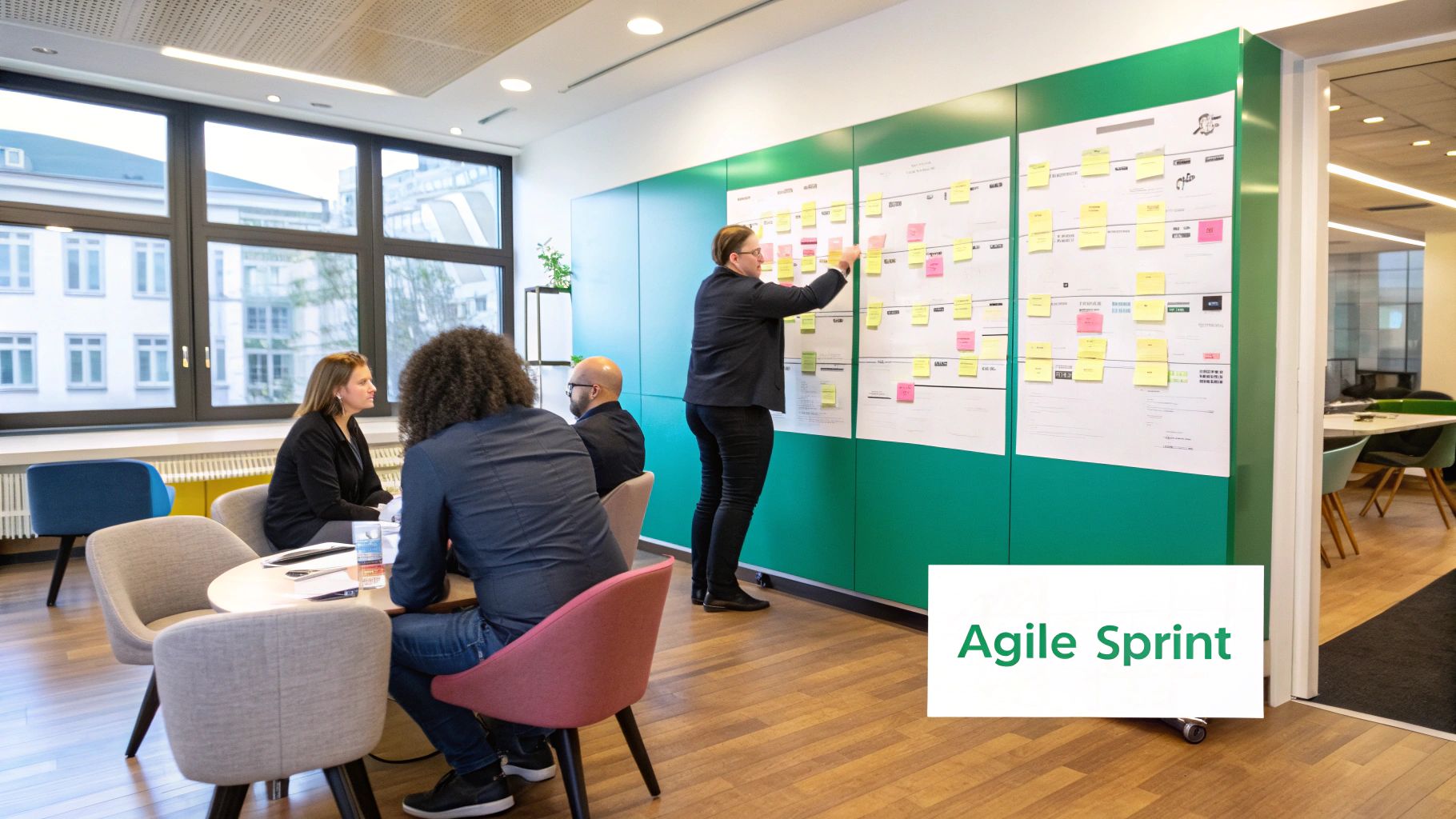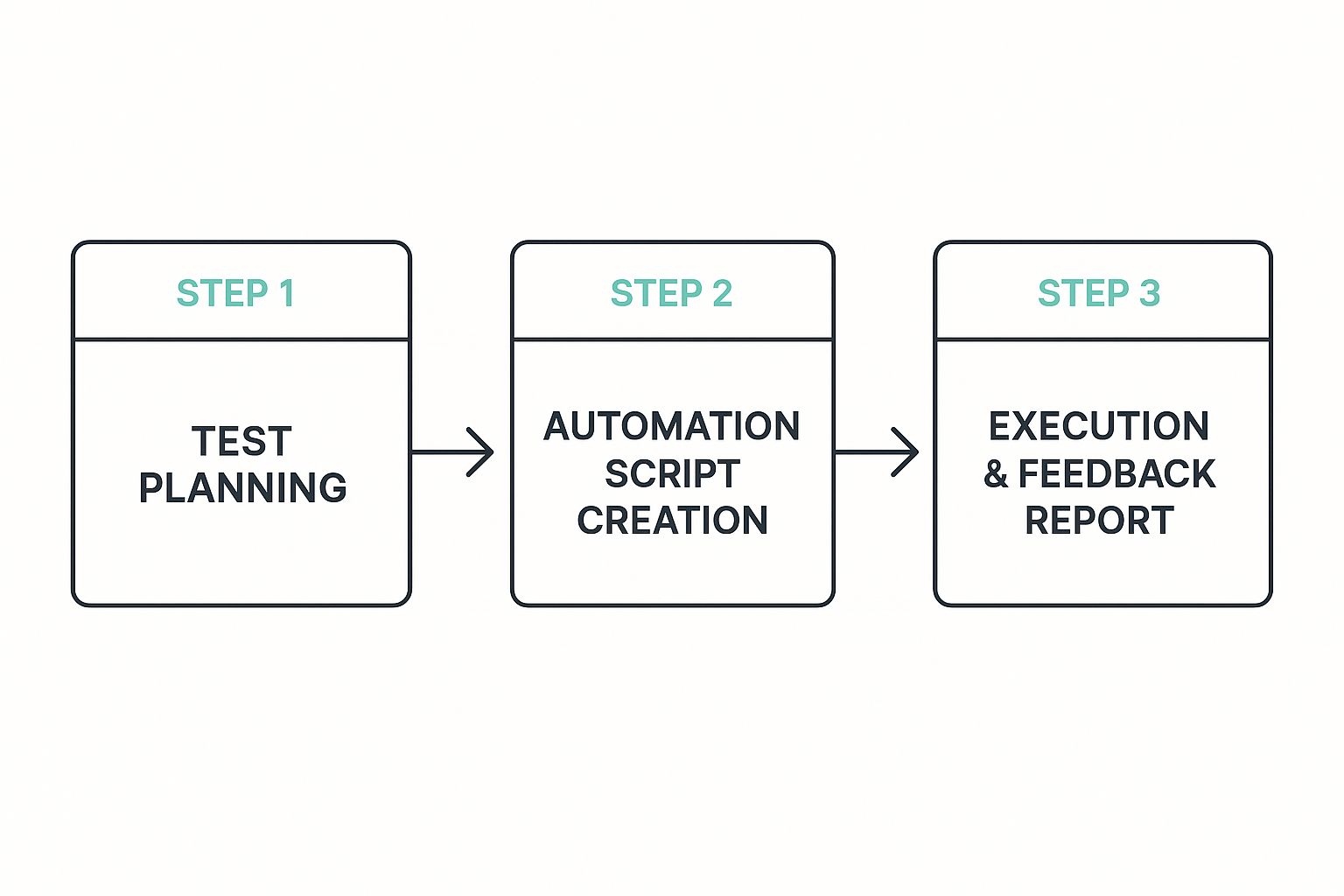Getting your product to market isn't just a race; it's the race that determines if you even get to compete. To win, you have to master the art of moving from a brilliant idea to a launched product faster than anyone else. This means zeroing in on the absolute core features for a Minimum Viable Product (MVP), getting it into users' hands, and using their feedback to iterate like your startup's life depends on it—because it does.
The Real Stakes of Speed in Today's Market

In a world overflowing with new products, speed is no longer just a nice-to-have advantage. It’s a core survival skill. Trimming down the time it takes to get from a concept on a napkin to a live product directly impacts your ability to grab market share, start generating revenue, and build a defensible moat.
Honestly, every single day you spend tweaking features in a silo is a day a competitor could be winning over the very customers you’re building for.
The whole game is about one thing: the sooner your product is being used by real people, the sooner you start that all-important feedback loop. This isn't just data; it's gold. It lets you pivot based on what the market actually wants, not what you think it wants, saving you from burning cash on features nobody asked for.
Why Digital Transformation Fuels the Need for Speed
The global shift toward digital-first everything is setting a blistering pace for startups. Customers expect more, faster, and your competitors are getting incredibly agile. It’s no surprise the digital transformation market was valued at a staggering $535 billion in 2022 and is on track to explode to $3.375 trillion by 2032. This isn't just a trend; it's a tidal wave powered by AI and cloud computing that lets teams build and ship faster than ever. You can dig into the numbers and see more digital transformation trends and statistics for yourself.
But it’s not just about the tech. It’s a complete shift in mindset. The companies that are actually winning are the ones that have baked speed into their DNA. They get that being first, even with a product that isn't perfect, is their chance to build a loyal tribe of early adopters.
"If you’re not embarrassed by the first version of your product, you’ve launched too late."
— Reid Hoffman, Co-founder of LinkedIn
This isn't just a clever quote; it's a foundational truth of building products today. Waiting for "perfect" is often just another way of saying you missed your window.
Tangible Benefits of a Faster Launch
Getting your product out the door quickly delivers real, tangible results. It’s not about bragging rights; it's about what being first empowers you to do.
- Capture Early Adopters: There's a whole group of tech-savvy users out there hungry for the next big thing. Launching fast puts you directly in their path, and they’ll give you the raw, unfiltered feedback you need while becoming your first evangelists.
- Generate Revenue Sooner: This one’s simple. The faster you launch, the faster you can start charging. That early revenue is the lifeblood that fuels your next round of development, marketing, and scaling.
- Build Market Momentum: A strong, early launch creates a story. It generates buzz, gets you on the radar of journalists and influencers, and sends a clear signal to the market that you're a force to be reckoned with.
To truly understand how these elements work together, it helps to see them as the core pillars supporting your entire go-to-market strategy.
Core Pillars of Accelerated Time to Market
Here’s a breakdown of the fundamental concepts that enable startups to launch products faster and more effectively. Each pillar builds on the others to create a powerful engine for growth.
| Pillar |
Description |
Impact on Speed |
| Lean Prototyping |
Building a bare-bones version (MVP) with only essential features to solve a core problem. |
Drastically cuts initial development time by avoiding "feature creep" and focusing resources. |
| Rapid Iteration |
A continuous cycle of building, measuring feedback, and learning to make quick, data-driven improvements. |
Allows for fast pivots and ensures the product evolves based on real user needs, not assumptions. |
| Agile Development |
Using flexible, sprint-based methodologies to break down large projects into small, manageable tasks. |
Creates momentum, improves team velocity, and makes it easier to adapt to changes on the fly. |
| Strategic Partnerships |
Collaborating with others—like finding the right co-founder—to fill skill gaps and share the workload. |
A well-matched co-founder can cut development time in half by bringing complementary expertise. |
By focusing on these four pillars, you shift from a slow, waterfall-style approach to a dynamic and responsive one. This isn't just about moving faster; it's about building smarter and giving your startup the best possible chance to succeed.
How a Co-Founder Can Double Your Launch Speed

If you're a solo founder, you know the feeling. The to-do list is a monster that never sleeps. You’re juggling product, marketing, sales, and admin—a guaranteed recipe for burnout and painful delays. I've seen it dozens of times.
The single biggest lever you can pull to accelerate time to market is finding the right co-founder. It’s not about just splitting the work; it’s about creating a force multiplier.
Think about it. A strategic partner instantly divides that immense pressure. One founder could be a technical guru, buried in code and perfecting the product. Meanwhile, their partner is a sales and marketing machine—building a pre-launch waitlist, locking in beta testers, and generating real buzz. It's parallel processing, something that’s just plain impossible for one person to pull off effectively.
Filling Critical Skill Gaps
Let's be honest, everyone has blind spots. A brilliant engineer might freeze up when trying to craft a compelling brand story. A marketing pro might not have the first clue about building a scalable backend. A co-founder with skills that complement yours plugs these gaps on day one, saving you from costly mistakes and months spent learning on the fly.
That synergy translates directly into speed. Instead of one person grinding through a long, sequential checklist, two people can execute at the same time.
- Product & Tech: While you’re building the MVP, your partner is already out there getting user feedback on mockups.
- Marketing & Biz Dev: As the product comes to life, your co-founder is networking with potential investors or lining up strategic partnerships.
This division of labor doesn’t just get things done faster—it makes the final product better. Each of you gets to operate in your zone of genius, leading to a stronger product and a launch strategy that actually works.
A partnership built on complementary skills can easily cut development and launch time in half. It’s the difference between a slow, linear grind and a dynamic, parallel sprint.
The Power of Shared Vision and Accountability
Beyond just the skills, a co-founder brings critical emotional and strategic support to the table. They’re your sounding board for new ideas, your source of motivation when things get tough, and the accountability partner who makes sure the project never stalls. That shared sense of ownership creates a powerful, forward-moving momentum.
But finding that perfect partner can feel like a massive roadblock on its own. The search can eat up the very time you’re trying to save. This is where you need a targeted approach. For instance, platforms like IndieMerger are built specifically to connect you with vetted, committed partners who share your drive and vision. If you need a playbook, our guide on how to find co-founders breaks down the entire process.
By locking in the right partner, you aren't just getting an extra pair of hands. You're building a foundation to slash your time to market and massively increase your startup's odds of making it.
Applying Lean and Agile Methods That Actually Work
Lots of founders get lost in the theory. To really slash your time to market, you have to get practical with lean and agile ideas. This isn't about throwing around buzzwords; it's about a disciplined mindset focused on one thing: shipping a product that delivers real value, and shipping it fast.
The whole game is about ruthlessly defining your Minimum Viable Product (MVP). And no, an MVP isn't a buggy, half-baked version of your grand vision. It's the simplest, most elegant solution to a single, critical problem your target customer has. Anything else is just noise that will tack weeks or months onto your timeline.
Focus on Impact-Driven Sprints
Once you have that crystal-clear MVP in your sights, the goal is to build, measure, and learn in rapid-fire cycles. Forget those long, drawn-out development plans. Break the work down into short, one-to-two-week sprints.
Each sprint needs to be laser-focused on shipping a small, functional piece of the product that you can get in front of real users. This creates an incredibly tight feedback loop. For example, a fintech startup might spend a single sprint building just the user sign-up and bank connection feature—and nothing else. The feedback from that one piece then tells them exactly what to build next.
This approach stops you from wasting months building something nobody actually wants. It forces you to prioritize tasks based on what delivers immediate customer impact, not just what looks good on a bloated feature list.
The question you have to ask constantly is: "What's the single most important thing we can build right now to test our core assumption and deliver value?" This keeps your team aligned and the project rocketing forward.
The Power of Rapid Feedback and Iteration
Gathering early user data is your secret weapon for lapping the competition. Imagine you launch a simple MVP and find out that 80% of users are ignoring a feature you were sure was essential, but they keep asking for something completely different. That insight is pure gold. It lets you pivot instantly, saving you from scaling a product built on a flawed foundation.
This agile workflow pairs perfectly with automated testing, which is crucial for keeping up your speed without letting quality slide. It's a simple process: you plan your tests, create automated scripts to run them, and get feedback reports almost immediately.
Here's a quick look at what that automated testing workflow looks like in practice:

This structured but flexible process means every development cycle adds validated, high-quality code, which directly helps you get to market faster. And the financial upside of this speed is huge. Research shows that companies using automation and agile strategies adapt way faster to market needs. On top of that, 73% of marketers see a faster time to market as a key win from their digital investments, linking it directly to staying ahead of the competition. You can dig into more of these digital transformation statistics to see the full impact.
Building a High-Velocity Go-To-Market Plan

It’s every founder’s nightmare: you build a brilliant product, but it ends up just collecting digital dust. To truly accelerate time to market, your launch strategy needs to be just as nimble and focused as your development cycle. Forget those sprawling, five-year roadmaps. What you need is a lean, high-velocity go-to-market (GTM) plan built for immediate impact.
The real secret here is to stop trying to be everything to everyone right out of the gate. Your first move is to lock in a "beachhead market"—a small, specific group of users who feel the pain you're solving more than anyone else. By zeroing in on them, you can craft your message and outreach for maximum effect, getting that critical early traction much faster than if you were just casting a wide, generic net.
Pre-Launch Buzz and Audience Building
Your launch day shouldn't be the first time anyone has ever heard of you. The goal is to have an eager audience waiting before you even flip the switch to go live. This all comes down to building a pre-launch community around the problem your product solves.
Start by embedding yourself in the online spaces where your beachhead market already hangs out. This could be a few niche subreddits, some active LinkedIn groups, or even specialized forums. Share your journey, offer real value without asking for a thing, and build genuine relationships. This groundwork is what turns a cold launch into a warm welcome from people who already feel like they know and trust you.
A powerful GTM strategy isn't just a post-development checklist. It's a parallel process. A well-aligned co-founder team can execute this strategy while the final product touches are being made, ensuring a seamless and rapid launch.
For example, while one co-founder is heads-down refining the last bits of code, the other can be out there lining up beta testers from that community you've built and creating all the content you'll need for launch day. Running these tasks in parallel is a massive advantage. We actually dig deeper into this in our guide on how to shorten time to market, which is all about coordinated founder efforts.
Rapid-Fire Marketing for Immediate Results
Once you have that targeted audience, you can roll out marketing tactics that get you results without needing a massive budget. These focused efforts are what will make or break a quick, successful launch.
- Targeted Digital Ads: Use platforms like Facebook or LinkedIn to run hyper-specific ad campaigns aimed squarely at your beachhead audience.
- Niche Community Engagement: Become a genuinely helpful member of relevant online communities. Position yourself as an expert before you even think about mentioning your product.
- Content Seeding: Create valuable content—think blog posts or short videos—that speaks directly to your audience's core problem, then share it where you know they'll see it.
This approach isn't just a founder-level hack; it’s reflected in broader market trends. Look at digital audio ad spending—it's projected to hit $12.16 billion in 2025. That’s a clear sign that brands are using highly targeted channels to make an immediate impact. As trends from sources like Deloitte Digital's 2025 marketing insights show, customers respond to timely and relevant brand experiences. That's exactly what a fast, well-executed GTM strategy delivers, proving that speed isn't just a feature—it's a holistic business strategy.
Using Modern Tools and Automation for Speed
Manual work is the single biggest anchor dragging down your launch timeline. Every hour you spend on a repetitive, mind-numbing task is an hour stolen from high-impact work like product strategy or actually talking to customers. To genuinely accelerate time to market, you have to build your startup on a modern tech stack, not just sheer willpower.
This isn't just about having fancy software; it's about creating an efficient engine that handles the grunt work. Doing so frees you and your co-founder to focus on what actually moves the needle. Having a tech-savvy partner is a massive advantage here—they can implement the systems that make the entire operation faster and smarter from day one.
Ditch Traditional Coding for Rapid Prototyping
The days of needing months of painstaking code just to see if an idea has legs are long gone. For founders who need to move at lightning speed, no-code and low-code platforms have completely changed the game.
Instead of hunting for a pricey development team or spending half a year trying to learn to code yourself, you can build a functional Minimum Viable Product (MVP) in a matter of days. Seriously. Think about it: a tool like Bubble lets you piece together a web application with a simple drag-and-drop interface. This gets a working prototype into the hands of real users almost immediately, letting you gather the raw, unfiltered feedback you need to validate your concept before sinking significant cash into it.
One of the most common traps I see founders fall into is "over-engineering" an MVP. A no-code tool forces you to stay focused on the core functionality, which is exactly what you need to test your assumptions and find a market—fast.
Automate the Build-Test-Deploy Cycle
For teams that are writing code, Continuous Integration/Continuous Deployment (CI/CD) pipelines are absolutely non-negotiable for speed. A CI/CD pipeline automates the entire process of testing and deploying new code, which eliminates manual bottlenecks and drastically reduces the chance of human error.
Whenever a developer pushes new code, it’s automatically built, tested, and shipped if it passes all the checks. This creates a high-velocity workflow where you can push updates multiple times a day instead of just once a month. This kind of rapid iteration is a huge competitive advantage, and you can learn more about it in our complete guide to accelerating product development.
Tools to Streamline Every Aspect of Your Launch
Your tech stack should extend far beyond just development. Here are a few essential tool categories that modern startups use to stay lean and move quickly:
- Project Management: Ditch the endless email chains and the "who's doing what?" confusion. Tools like Asana, Trello, or Jira are vital for keeping everyone aligned and accountable.
- Marketing Automation: Platforms like Mailchimp or HubSpot can handle email nurturing, social media scheduling, and lead capture. This lets a marketing co-founder build an audience while your tech co-founder is still finalizing the product.
By building a machine powered by the right tools and automation, you stop trading your limited time for progress and start building real momentum. This is exactly how you outpace competitors and get to market while your idea is still fresh and exciting.
Got Questions About Launching Faster? We’ve Got Answers.
When you’re racing to launch, it feels like every single decision carries a ton of weight. Founders, especially first-timers, get hung up on the same questions, constantly second-guessing the tradeoffs between speed and quality.
Let's cut through the noise and tackle these common hurdles head-on.
Is "Launching Fast" Just Another Way of Saying "Bad Product"?
This is the big one. It's the fear that keeps founders tweaking features for months on end. But launching fast isn't about shipping a broken mess—it's about shipping a focused one. The real goal is to release a high-quality Minimum Viable Product (MVP) that solves one specific problem incredibly well.
Think of it this way: instead of spending a year building a complicated Swiss Army knife, you launch a single, perfectly designed screwdriver in a month. It only does one job, but it does it flawlessly. This strategy gets your product into the hands of real users so you can get feedback before you waste time and money on features no one actually wants.
The biggest risk isn't launching an imperfect product. It's spending two years building a "perfect" product that nobody needs. Speed lets you test your core assumptions while you still have the runway to pivot.
How Can I Possibly Find Time for Marketing While I’m Building?
It’s the classic solo founder’s nightmare. You’re buried in code, squashing bugs, and the thought of stopping to write a blog post or set up an ad campaign feels completely overwhelming.
The honest answer? You can't do both effectively at the same time. This is where having a partner isn't just a nice-to-have; it's a strategic advantage that unlocks parallel progress.
This is the exact reason finding a co-founder with complementary skills is so powerful. While one person builds, the other markets.
- The Builder (You?): Your world is sprints, bug fixes, and refining the core product.
- The Marketer (Your Co-founder): Their world is building a waitlist, creating launch content, and talking to potential customers.
This isn't just about splitting a to-do list. It's about ensuring both critical functions are executed with focus and excellence. It's one of the most reliable ways to slash your time to market without letting product quality or launch momentum suffer.
What if Competitors See My Idea and Steal It?
This fear paralyzes so many founders. They worry that launching early just puts a target on their back, inviting a bigger, better-funded competitor to swoop in and copy their idea.
While it's not impossible, this threat is almost always overblown.
First, your idea is maybe 1% of your future success. Execution is everything. By launching quickly and building a community around your first users, you create a massive head start. A competitor can copy your features, but they can't copy the relationships you've built with your customers.
Second, speed is your best defense. While a big corporation is stuck in committee meetings and drowning in red tape, you can be iterating and improving based on real-time feedback. By the time they finally launch their clone, you’re already two steps ahead, building the next thing your users are begging for.
The hard truth is that of the thousands of startups that fail each year, very few fail because their idea was stolen. The vast majority fail because they never found a market. Launching fast is your best weapon for finding that market before the money runs out.
Are you a solo founder trying to juggle it all? The right partner can slash your time to market and turn your vision into reality, faster. Find your perfect match on IndieMerger. With a database of verified founders and AI-powered matching, you can connect with a co-founder who complements your skills and shares your drive. Stop building alone and start building your future. Get started on IndieMerger today!